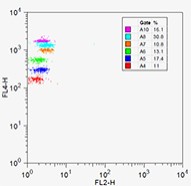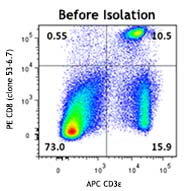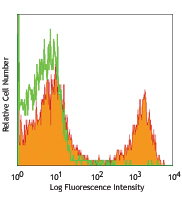- Regulatory Status
- RUO
- Ave. Rating
- Submit a Review
- Product Citations
- publications

-

Beads A: Six sets of smaller beads separated by FL4 (APC) Channel on FACSCalibur™
| Cat # | Size | Price | Quantity Check Availability | Save | ||
|---|---|---|---|---|---|---|
| 740169 | 1 vial | 142€ | ||||
LEGENDplex™ Carboxyl Beads are fluorescent particles designed for the multiple assay development using flow cytometers. Beads include two sizes, i.e., 5 µm and 7 µm, designated as A or B beads, and each bead set has different levels of APC fluorescence, allowing them to be clearly distinguished from each other. The functionalized carboxyl group can be used for the conjugation of antibody and streptavidin.
Product DetailsProduct Details
- Formulation
- Each vial contains 107 particles (10 million) per mL.
- Storage & Handling
- Store between 2°C and 8°C.
- Application
-
Multiplex
Learn more about LEGENDplex™ at biolegend.com/legendplex
Download the LEGENDplex™ software here. - Application Notes
-
LEGENDplex™ Carboxyl Beads are intended for do-it-yourself conjugations to create your own assays. Please refer to the conjugation protocol here.
Antigen Details
- Gene ID
- NA
Related Pages & Pathways
Pages
Related FAQs
- If I don't have a vacuum, how do I remove the liquid from my plate?
-
If you do not have a vacuum, the assay should be run in a V-bottom plate. After centrifugation using a swinging-bucket rotor with a plate adaptor, you can remove the liquid by flicking the plate quickly, dumping the contents into a sink, and patting it dry carefully on a stack of clean paper towels without losing the beads. Alternatively, you can remove the liquid by using a pipette.
- Should I perform the assay with the filter plates or with V-bottom plates?
-
Filter plates or V-bottom plates have been included in some kits for your convenience. A vacuum filtration unit is required to work with the filter plates. However, if you don’t have access to a vacuum manifold or if you prefer, then you can use the V-bottom plates and follow the recommended assay protocols for the type of plates you choose. All plates should be made from low binding polypropylene. Polystyrene ELISA or cell culture plates should not be used.
- After I finish the staining process, how long can I wait before reading my LEGENDplex™ samples?
-
The samples can be kept overnight at 4°C while being protected from exposure to light and be read the next day. There may be a decrease in signal, but overall, the assay results should not be affected. Storing the samples for extended periods of time is not recommended, as it could lead to further reductions in signal.
- What is the shelf life of LEGENDplex™ kits?
-
LEGENDplex™ kits are guaranteed for 6 months from the date of receipt, but may have a shelf life of up to 2 years from the date of manufacture.
- Is special software required for data analysis?
-
Typically flow cytometers generate output files in FCS format (e.g. FCS 2.0, 3.0, or 3.1) and in some cases in list mode file format (LMD). Other software may be available to analyze FCS files. Data generated using LEGENDplex™ kits can be analyzed using the freely available LEGENDplex™ data analysis software. Please check our website for the most updated versions of the software.

 Login / Register
Login / Register 












Follow Us